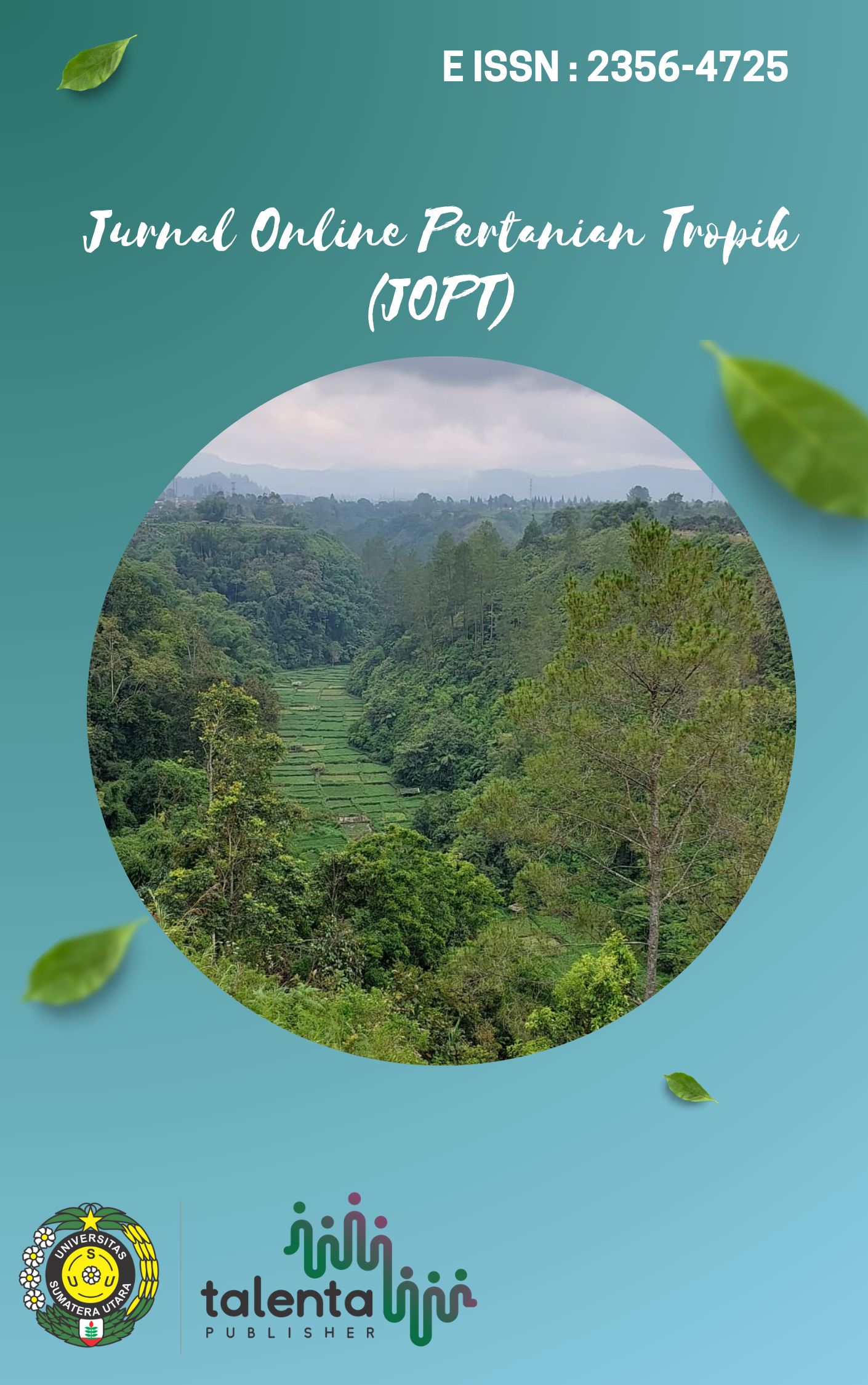Agronomy Performance and Resistance of Shallots against Fusarium Wilt Disease under Various Salicylic Acid Treatments
DOI:
https://doi.org/10.32734/jopt.v9i2.9500Keywords:
Keywords: Concentration of salicylic acid, Fusarium acutatum, incidence of disease, Tajuk varietyAbstract
This research aims to know the agronomic character and resistance of shallots against fusarium wilt disease under various salicylic acid treatments. This research was conducted in a greenhouse using a completely randomized design with one factor, namely the treatment of salicylic acid concentrations (0 ppm, 15 ppm, 20 ppm, and 25 ppm) with 3 replications. Each treatment was inoculated with Fusarium acutatum inoculum (106 conidia ml-1 distilled water) except for the negative control, without being inoculated with Fusarium acutatum inoculum. The materials used included shallot bulbs of the Tajuk variety, synthetic salicylic acid, Fusarium acutatum inoculum. Variables of observation of agronomic characters include; plant height, number of leaves, fresh tuber weight while the disease component variables include; incubation period, and disease incidence. The data obtained were analyzed by analysis of variance (ANOVA) with a significance level of 95%, then the DMRT test (95%) was carried out to determine the differences between treatments. The results of the analysis of variance showed that there was a significant difference between the 0 ppm treatment (control) and the 15, 20, and 25 ppm treatment on the characters of plant height, fresh weight, and disease incidence. Meanwhile for the character of the number of leaves and incubation period there was no significant difference between the control and salicylic acid treatment. Salicylic acid treatment at a concentration of 15 ppm showed the highest plant height (34.26 cm), the highest number of leaves (24.46 strands), the highest fresh tuber weight (6.30 g), and the least disease incidence (14.55%).
Downloads
References
Agrios, G.N. 2005. Plant Pathology. Fifth Edition. Academic Press. San Diege USA . 948p
Bideshki, A. & Arvin, M.J. 2011. Effect of salicylic acid (SA) and drought stress on growth, bulb yield and allicin content of garlic (Allium sativum) in field. Plant Ecophysiology 2: 73 – 79.
Dihazi, A., Seghini, M.A., Jaiti, F., Daayf, F., Driouich, A., Dihazi, H. & El Hadramil, I. 2011. Structural and biochemical changes in salicylic acid treated date palm root challenged with Fusarium oxysporum f.sp. albedinis. SAGE Hindawi Access to Research Journal of Pathogens. 280481. DOI: http://dx.doi.org/10.4061/2011/280481
Fadhilah, S. 2014. Pengembangan teknik deteksi fusarium patogenik pada umbi bibit bawang merah (Allium cepa L. var ascalonicum Backer). Tesis. Institut Pertanian Bogor. Bogor.
Faradilla. 2011. Induksi ketahanan pisang terhadap Fusarium oxysporum f.sp cubense dengan asam salisilat dan asam fusarat dalam kultur jaringan. Tesis. Universitas Gadjah Mada. Yogyakarta.
Juwanda M, Khotimah K, Amin M. 2016. Peningkatan ketahanan bawang merah terhadap penyakit layu fusarium melalui induksi ketahanan dengan asam salisilat secara in vitro. J. Agrin 20(1): 15 – 28.
Khotimah K, Endang S, Wibowo A. 2017. In vitro induced resistance of fusarium wilt disease (fusarium oxysporum f.sp. cepae) by Salicylic Acid in Shallot Cv. ‘Bima Brebes’. Ilmu Pertanian (Agricultural Science) 2(1): 001 – 008. DOI:http://doi.org/10.22146/ipas.12840.
Lestiyani, A. 2015. Identifikasi, patogenitisitas, dan variabilitas penyebab penyakit moler pada bawang merah. Tesis. Universitas Gadjah Mada. Yogyakarta.
Muhal, S., Solanki, N. S., Singh, P., & Shukla, K. B. 2014. Effect of SA on productivity and nutrient uptake on Brasica species under different planting durations. African Journal of Agricultural 19(13): 1101 – 1106.
Ryals, J. A., Neuenschwander, U., Willits, M., Molina, A., Steiner, H.Y. & Hunt, M. 1996. Systemic acquired resistance. Plant Cell 8: 1809–1819.
Sulistiana, E. & Sukma, D. 2014. Pertumbuhan anggrek Phalaenopsis amabilis pada perlakuan chitosan dan asam salisilat. Bul. Agrohorti 2(1): 75 – 85.
Vicente, M.R.S. & Plasencia, J. 2011. Salicylic acid beyond defence: its role in plant growth and development. Journal of Experimental Botany 62(10): 3321 – 3338.
Vlot, A.C., Dempsey, D.A. & Klessig, D.F. 2009. Salicylic acid, a multifaceted hormone to combat disease. Ann. Rev. Phytopathol. 47: 177 – 206. DOI: http://dx.doi.org/10.1146/annurev.phyto/050908.135202.
Downloads
Published
How to Cite
Issue
Section
License
Copyright (c) 2022 Jurnal Pertanian Tropik

This work is licensed under a Creative Commons Attribution-ShareAlike 4.0 International License.






















